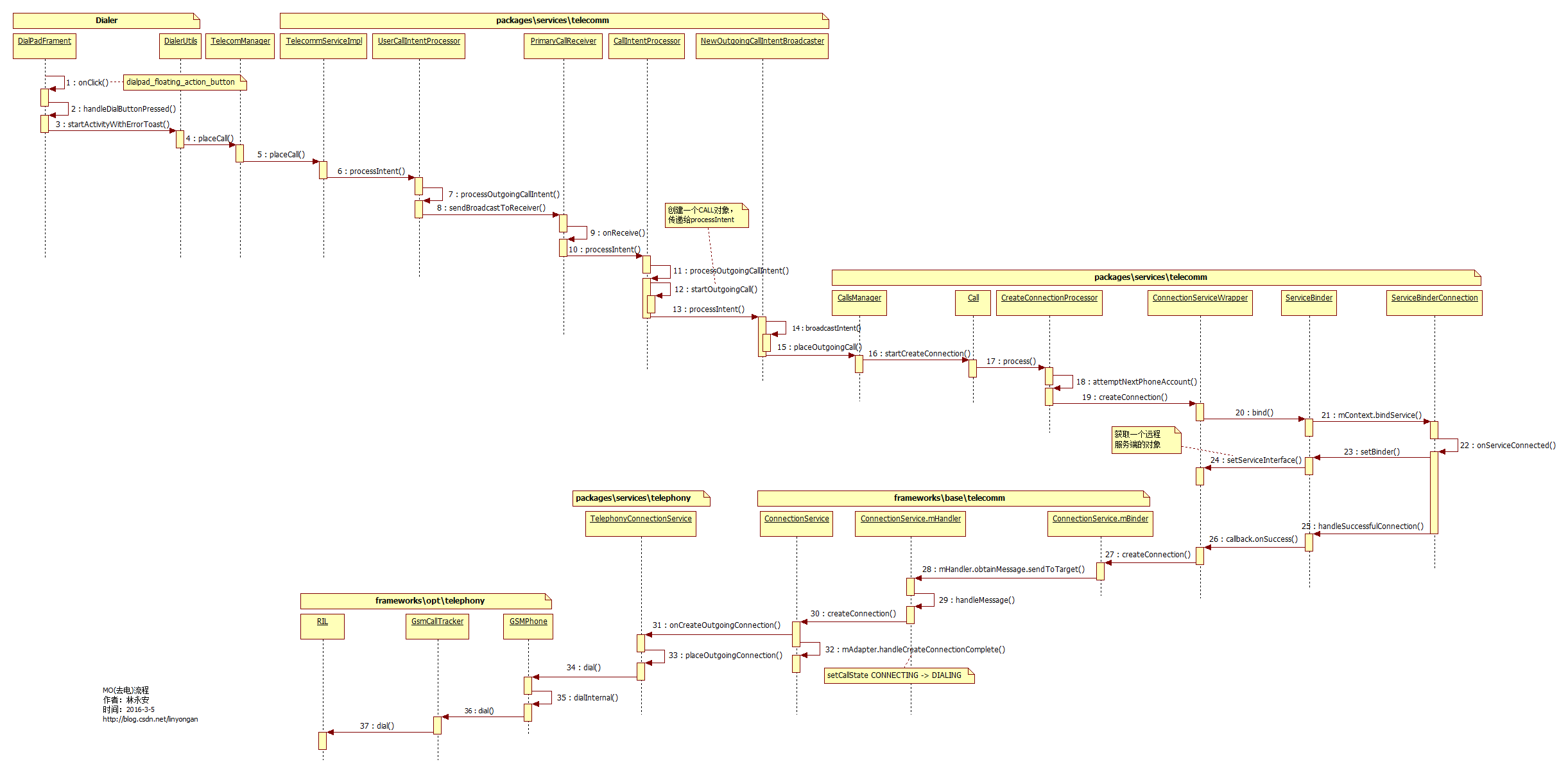Android 6.0 Phone MO(去電)流程分析(應用層)
寫在前面的話
本文主要分析MO(去電)的流程,研究的程式碼是Android 6.0的,目前只關注應用層,以GSM為例。

步驟1:當用戶點選撥號鍵盤按鈕(DialtactsActivity的floating_action_button),彈出撥號盤,輸入完電話號碼,再點選撥號按鈕,此時打電話的流程開始,因此打電話流程的入口就在DialpadFragment.java(packages\apps\dialer\src\com\android\dialer\dialpad)的onClick()方法
public void onClick(View view) {
switch (view.getId()) {
case R.id.dialpad_floating_action_button:
mHaptic.vibrate();
handleDialButtonPressed();
...
}步驟2:在handleDialButtonPressed()方法裡,會先判斷使用者是否已輸入號碼,假如號碼為空,則呼叫handleDialButtonClickWithEmptyDigits()方法顯示上一次撥打過的號碼。然後第一次獲取到要撥打的number,在這裡可以對number做一些判斷或者自定義處理。
步驟11,12:在CallIntentProcessor.java的processOutgoingCallIntent()方法裡,呼叫
Call call = callsManager.startOutgoingCall(handle, phoneAccountHandle, clientExtras);
(這就是Call物件的來源),最後傳遞給NewOutgoingCallIntentBroadcaster。
步驟13:在NewOutgoingCallIntentBroadcaster.java的processIntent()方法裡,第二次獲取到要撥打的number,這裡也是對number進行一些定製操作的好地方。在這裡會呼叫isPotentialEmergencyNumber()方法判斷number是否是潛在的緊急號碼,如果是緊急號碼會直接走步驟15。
/**
* Processes the supplied intent and starts the outgoing call broadcast process relevant to the
* intent.
*
* This method will handle three kinds of actions:
*
* - CALL (intent launched by all third party dialers)
* - CALL_PRIVILEGED (intent launched by system apps e.g. system Dialer, voice Dialer)
* - CALL_EMERGENCY (intent launched by lock screen emergency dialer)
*
* @return {@link DisconnectCause#NOT_DISCONNECTED} if the call succeeded, and an appropriate
* {@link DisconnectCause} if the call did not, describing why it failed.
*/
int processIntent() {
...
//第二次獲取到number
String number = PhoneNumberUtils.getNumberFromIntent(intent, mContext);
//判斷是不是EmergencyNumber
final boolean isPotentialEmergencyNumber = isPotentialEmergencyNumber(number);
Log.v(this, "isPotentialEmergencyNumber = %s", isPotentialEmergencyNumber);
// True for certain types of numbers that are not intended to be intercepted or modified
// by third parties (e.g. emergency numbers).
boolean callImmediately = false;
if (Intent.ACTION_CALL.equals(action)) {
if (isPotentialEmergencyNumber) {
if (!mIsDefaultOrSystemPhoneApp) {//攔截第三方軟體撥打的緊急號碼
Log.w(this, "Cannot call potential emergency number %s with CALL Intent %s "
+ "unless caller is system or default dialer.", number, intent);
launchSystemDialer(intent.getData());//彈出系統撥號盤
return DisconnectCause.OUTGOING_CANCELED;
} else {
callImmediately = true;//緊急電話的標誌
}
}
} else if (Intent.ACTION_CALL_EMERGENCY.equals(action)) {
if (!isPotentialEmergencyNumber) {//攔截在緊急撥號盤撥打的非緊急電話
Log.w(this, "Cannot call non-potential-emergency number %s with EMERGENCY_CALL "
+ "Intent %s.", number, intent);
return DisconnectCause.OUTGOING_CANCELED;
}
callImmediately = true; //緊急電話的標誌
} else {
Log.w(this, "Unhandled Intent %s. Ignoring and not placing call.", intent);
return DisconnectCause.INVALID_NUMBER;
}
if (callImmediately) {//處理緊急號碼
Log.i(this, "Placing call immediately instead of waiting for "
+ " OutgoingCallBroadcastReceiver: %s", intent);
String scheme = isUriNumber ? PhoneAccount.SCHEME_SIP : PhoneAccount.SCHEME_TEL;
boolean speakerphoneOn = mIntent.getBooleanExtra(
TelecomManager.EXTRA_START_CALL_WITH_SPEAKERPHONE, false);
int videoState = mIntent.getIntExtra(
TelecomManager.EXTRA_START_CALL_WITH_VIDEO_STATE,
VideoProfile.STATE_AUDIO_ONLY);
mCallsManager.placeOutgoingCall(mCall, Uri.fromParts(scheme, number, null), null,
speakerphoneOn, videoState);//快速處理緊急電話,但是並不return。
// Don't return but instead continue and send the ACTION_NEW_OUTGOING_CALL broadcast
// so that third parties can still inspect (but not intercept) the outgoing call. When
// the broadcast finally reaches the OutgoingCallBroadcastReceiver, we'll know not to
// initiate the call again because of the presence of the EXTRA_ALREADY_CALLED extra.
}
Log.i(this, "Sending NewOutgoingCallBroadcast for %s", mCall);
//普通電話走這裡
if (isSkipSchemaParsing) {
broadcastIntent(intent, handle.toString(), !callImmediately);
} else {
broadcastIntent(intent, number, !callImmediately);
}
return DisconnectCause.NOT_DISCONNECTED;
}步驟15:在這裡呼叫了
/**
* Attempts to issue/connect the specified call.
*
* @param handle Handle to connect the call with.
* @param gatewayInfo Optional gateway information that can be used to route the call to the
* actual dialed handle via a gateway provider. May be null.
* @param speakerphoneOn Whether or not to turn the speakerphone on once the call connects.
* @param videoState The desired video state for the outgoing call.
*/
void placeOutgoingCall(Call call, Uri handle, GatewayInfo gatewayInfo, boolean speakerphoneOn,
int videoState) {
//判斷是不是緊急電話
boolean isEmergencyCall = TelephonyUtil.shouldProcessAsEmergency(mContext,
call.getHandle());
……
if (isEmergencyCall) {
// Emergency -- CreateConnectionProcessor will choose accounts automatically
call.setTargetPhoneAccount(null);
}
if (call.getTargetPhoneAccount() != null || isEmergencyCall) {
if (!isEmergencyCall) {
updateLchStatus(call.getTargetPhoneAccount().getId());
}
// If the account has been set, proceed to place the outgoing call.
// Otherwise the connection will be initiated when the account is set by the user.
call.startCreateConnection(mPhoneAccountRegistrar);
} }
}步驟16: call例項被傳送到這裡,終於派上用場了,進入
/**
* Starts the create connection sequence. Upon completion, there should exist an active
* connection through a connection service (or the call will have failed).
*
* @param phoneAccountRegistrar The phone account registrar.
*/
void startCreateConnection(PhoneAccountRegistrar phoneAccountRegistrar) {
Preconditions.checkState(mCreateConnectionProcessor == null);
mCreateConnectionProcessor = new CreateConnectionProcessor(this, mRepository, this,
phoneAccountRegistrar, mContext);
mCreateConnectionProcessor.process();
}步驟17和18:繼續把Call傳遞給
private void attemptNextPhoneAccount() {
...
if (mResponse != null && attempt != null) {
Log.i(this, "Trying attempt %s", attempt);
ConnectionServiceWrapper service = mRepository.getService(
attempt.connectionManagerPhoneAccount.getComponentName());
if (service == null) {
Log.i(this, "Found no connection service for attempt %s", attempt);
attemptNextPhoneAccount();
} else {
mCall.setConnectionManagerPhoneAccount(attempt.connectionManagerPhoneAccount);
mCall.setTargetPhoneAccount(attempt.targetPhoneAccount);
mCall.setConnectionService(service);
Log.i(this, "Attempting to call from %s", service.getComponentName());
service.createConnection(mCall, new Response(service));
}
}
}這樣的話,Call物件就被傳遞到ConnectionServiceWrapper裡了。
(讀者最好先學習一下AIDL相關知識再繼續閱讀)
步驟20,21,22:這裡呼叫了ConnectionServiceWrapper的父類ServiceBinder的bind()方法,先new一個ServiceConnection物件,然後繫結一個遠端服務端服務。如果繫結成功的話,在ServiceBinder的內部類ServiceBinderConnection的onServiceConnected()方法就被呼叫。
在這裡做了兩件事:
1、步驟23和24:通過setBinder()方法,回撥ConnectionServiceWrapper的setServiceInterface()方法,通過mServiceInterface = IConnectionService.Stub.asInterface(binder);
這行程式碼獲取一個遠端服務端的物件mServiceInterface 。
2、步驟25和26:再通過呼叫handleSuccessfulConnection()方法回撥callback 的onSuccess()方法,也就又回到ConnectionServiceWrapper的createConnection()方法裡。
步驟27:最後通過這一行mServiceInterface.createConnection();
,呼叫
private final IBinder mBinder = new IConnectionService.Stub() {
...
@Override
public void createConnection(PhoneAccountHandle connectionManagerPhoneAccount,
String id,ConnectionRequest request,
boolean isIncoming,boolean isUnknown) {
SomeArgs args = SomeArgs.obtain();
args.arg1 = connectionManagerPhoneAccount;
args.arg2 = id;
args.arg3 = request;
args.argi1 = isIncoming ? 1 : 0;
args.argi2 = isUnknown ? 1 : 0;
mHandler.obtainMessage(MSG_CREATE_CONNECTION, args).sendToTarget();
}
...
}步驟28:在這裡把傳進來的引數封裝到Message裡再發送出去,然後在
private final Handler mHandler = new Handler(Looper.getMainLooper()) {
@Override
public void handleMessage(Message msg) {
switch (msg.what) {
case MSG_CREATE_CONNECTION: {
SomeArgs args = (SomeArgs) msg.obj;
try {
final PhoneAccountHandle connectionManagerPhoneAccount =
(PhoneAccountHandle) args.arg1;
final String id = (String) args.arg2;
final ConnectionRequest request = (ConnectionRequest) args.arg3;
final boolean isIncoming = args.argi1 == 1;
final boolean isUnknown = args.argi2 == 1;
if (!mAreAccountsInitialized) {
Log.d(this, "Enqueueing pre-init request %s", id);
mPreInitializationConnectionRequests.add(new Runnable() {
@Override
public void run() {
createConnection(connectionManagerPhoneAccount,
id,
request,
isIncoming,
isUnknown);
}
});
} else {
createConnection(connectionManagerPhoneAccount,
id,
request,
isIncoming,
isUnknown);
}
} finally {
args.recycle();
}
break;
}
...
}步驟29,30,31:在這裡就把Message裡的資料取出來,然後傳遞到ConnectionService的createConnection()方法裡。接著onCreateOutgoingConnection()會被呼叫到,這個方法被TelephonyConnectionService重寫,TelephonyConnectionService是ConnectionService的例項,所以進入
public Connection onCreateOutgoingConnection(
PhoneAccountHandle connectionManagerPhoneAccount,
final ConnectionRequest request) {
...
// 判斷是不是緊急號碼
boolean isEmergencyNumber = PhoneNumberUtils.isLocalEmergencyNumber(this, number);
// Get the right phone object from the account data passed in.
//建立phone 物件
final Phone phone = getPhoneForAccount(request.getAccountHandle(), isEmergencyNumber);
if (phone == null) {
Log.d(this, "onCreateOutgoingConnection, phone is null");
return Connection.createFailedConnection(
DisconnectCauseUtil.toTelecomDisconnectCause(
android.telephony.DisconnectCause.OUT_OF_SERVICE, "Phone is null"));
}
...
//建立connection物件
final TelephonyConnection connection =
createConnectionFor(phone, null, true /* isOutgoing */, null);
if (connection == null) {
return Connection.createFailedConnection(
DisconnectCauseUtil.toTelecomDisconnectCause(
android.telephony.DisconnectCause.OUTGOING_FAILURE,
"Invalid phone type"));
}
connection.setAddress(handle, PhoneConstants.PRESENTATION_ALLOWED);
connection.setInitializing();
connection.setVideoState(request.getVideoState());
if (useEmergencyCallHelper) {
if (mEmergencyCallHelper == null) {
mEmergencyCallHelper = new EmergencyCallHelper(this);
}
//開啟Radio,關閉飛航模式
mEmergencyCallHelper.startTurnOnRadioSequence(phone,
new EmergencyCallHelper.Callback() {
@Override
public void onComplete(boolean isRadioReady) {
if (connection.getState() == Connection.STATE_DISCONNECTED) {
// If the connection has already been disconnected, do nothing.
} else if (isRadioReady) {
//Radio已被開啟,可以撥打緊急電話
connection.setInitialized();
placeOutgoingConnection(connection, phone, request);
} else {
Log.d(this, "onCreateOutgoingConnection, failed to turn on radio");
connection.setDisconnected(
DisconnectCauseUtil.toTelecomDisconnectCause(
android.telephony.DisconnectCause.POWER_OFF,
"Failed to turn on radio."));
connection.destroy();
}
}
});
} else {
placeOutgoingConnection(connection, phone, request);
} return connection;
}步驟32:在步驟30createConnection()方法的最後,呼叫了ConnectionServiceAdapter.java的handleCreateConnectionComplete()方法繼續執行了一段流程,在建立Connection完成之後,會把Call的狀態從CONNECTING更新為 DIALING。此段流程就不詳說了。
步驟34~37:緊接著步驟33,最後通過phone.dial進行撥號,之後的流程就進入到Framework層了。
本文就寫到這裡。
